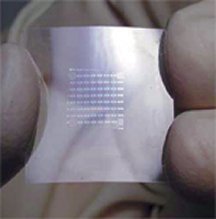Transparent Transistor: See-through component for flexible displays
- More than 2 years ago
Imagine a car windshield that suddenly lights up to reveal a map of the city and directions to your next destination. Or picture a computer display that you can not only see through but also roll into a tube and slip into your coat pocket. Scientists in Japan have taken a major step to fulfilling such visions with the creation of a transparent transistor deposited on plastic.

Hideo Hosono and his colleagues at the Tokyo Institute of Technology developed a transparent semiconductor material out of indium gallium zinc oxide. Although other research groups have previously made transparent circuitry, “their performance was not so good,” says Hosono. In contrast, prototype transistors made from his team’s new material are 10 times as conductive as the silicon transistors used in today’s liquid-crystal displays.
Hosono attributes his material’s success to the greater mobility of electrons when a voltage is applied.
“This is the first time I’ve seen a transparent transistor on a plastic substrate with such high performance,” says Edzer Huitema of Philips Research Laboratories in Eindhoven, the Netherlands. “This opens up a range of new applications.”
Depositing standard silicon transistors on plastic is nearly impossible since the process requires much heat. “That would melt the plastic,” says Huitema. However, the indium gallium zinc oxide goes onto plastic at room temperature. The researchers describe their new material in the Nov. 25 Nature.
“This paper is exciting,” says John Rogers of the University of Illinois at Urbana-Champaign. “The area of flexible electronics has attracted a great deal of attention over the last few years.” For instance, a number of groups in academia and industry have created electronic components out of organic materials for flexible computer displays (SN: 1/31/04, p. 67: Flexible E-Paper: Plastic circuits drive paperlike displays). However, none of these materials is transparent.
In addition to providing a host of specialty applications, transparent circuitry could make existing displays brighter by increasing the amount of light reaching the viewer’s eyes, adds Rogers.
As in all new technologies, devising methods for mass production presents a technical hurdle. The method that the researchers used to deposit the transistors on plastic isn’t amenable to large-scale manufacturing, says Tobin Marks of Northwestern University in Evanston, Ill. He notes that it remains to be seen whether the researchers can find a method for making large quantities of high-quality transistors.
Hosono says that his group is collaborating with an electronics company to develop the technology. Through this partnership, he plans to sort out the manufacturing issues and improve the material’s long-term stability.







